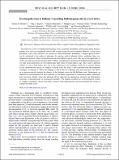Exciton-polaritons in flatland : controlling flatband properties in a Lieb lattice
Abstract
In recent years, novel two-dimensional materials such as graphene, bismuthene, and transition-metal dichalcogenides have attracted considerable interest due to their unique physical properties. However, certain lattice geometries, such as the Lieb lattice, do not exist as atomic monolayers. Fortunately, a range of physical effects can be transferred to the realms of photonics by creating artificial photonic lattices emulating these two-dimensional materials. Here, exciton-polaritons in semiconductor microcavities offer an exciting opportunity to study a part-light, part-matter quantum fluid of light in a complex lattice potential. In this Rapid Communication, we study exciton-polaritons in a two-dimensional Lieb lattice of buried optical traps. The S and Pxy photonic orbitals of such a Lieb lattice give rise to the formation of two flatbands which are of greatest interest for the distortion-free storage of compact localized states. By using a well controlled etch-and-overgrowth technique, we manage to control the trapping as well as the site couplings with great precision. This allows us to spectroscopically monitor the flatness of the flatbands across the full Brillouin zone. Furthermore, we demonstrate experimentally that these flatbands can be directly populated by condensation under nonresonant laser excitation. Finally, using this advanced device approach we demonstrate resonant and deterministic excitation of flatband modes in transmission geometry. Our findings establish the exciton-polariton systems as a highly controllable, optical many-body system to study flatband effects and for distortion-free storage of compact localized states.
Citation
Harder , T H , Egorov , O A , Beierlein , J , Gagel , P , Michl , J , Emmerling , M , Schneider , C , Peschel , U , Höfling , S & Klembt , S 2020 , ' Exciton-polaritons in flatland : controlling flatband properties in a Lieb lattice ' , Physical Review. B, Condensed matter and materials physics , vol. 102 , no. 12 , 121302(R) . https://doi.org/10.1103/PhysRevB.102.121302
Publication
Physical Review. B, Condensed matter and materials physics
Status
Peer reviewed
ISSN
2469-9950Type
Journal article
Description
Funding: T.H.H., J.B., P.G., J.M., M.E., C.S., S.H., and S.K. acknowledge financial support by the German Research Foundation (DFG) under Germany’s Excellence Strategy–EXC2147 “ct.qmat” (project id 390858490). S.K., J.B., U.P., and O.A.E. acknowledge support by the German Research Foundation (DFG) within project KL2431/2-1. S.H. is furthermore grateful for support within the EPSRC Hybrid Polaritonics Grant (Grant No. EP/M025330/1). T.H.H. and S.H. acknowledge funding by the doctoral training program Elitenetzwerk Bayern Graduate School “Topological insulators.” T.H.H. acknowledges support by the German Academic Scholarship Foundation.Collections
Items in the St Andrews Research Repository are protected by copyright, with all rights reserved, unless otherwise indicated.

